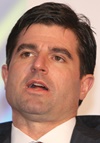In just the past two weeks, Scott O’Neil has been named CEO of the Philadelphia 76ers, Chris Granger has been named president of the Sacramento Kings, and Lou DePaoli has been named chief revenue officer of the New York Mets. Different jobs, to be sure, but the three executives share one specific business pedigree: Each came out of the NBA’s team marketing and business operations department, a group that increasingly is serving as an executive pipeline to some of the top jobs in sports.
Known by the acronym TMBO, the division comprises about 40 staff members who are responsible for developing, compiling, analyzing and sharing among teams ways to drive franchise profitability. While other leagues have executives with club-relations responsibilities, none has TMBO’s level of dedicated staff and structure.
The NBA TMBO executive tree
Bill Sutton
Helped create TMBO during his 1999-2001 tenure at the NBA. Left to teach at the University of Central Florida. Currently runs his own sports consultancy and the sports marketing graduate program at the University of South Florida.
Bernie Mullin
First director of TMBO, from 2000-04. Left to become CEO of Atlanta Spirit, owner of the NBA Hawks and former NHL Thrashers. Currently runs the sports consultancy The Aspire
Group.
Scott O’Neil
Ran TMBO from 2004-08. Left to work as president of Madison Square Garden Sports, 2008-12. Hired on July 8 as CEO of the Philadelphia 76ers.
Chris Granger
Succeeded O’Neil and ran TMBO from 2008 until this month. Takes over Aug. 1 as president of the Sacramento Kings.
Lou DePaoli
Was a vice president with TMBO from 2000-05. Left to work as CMO of Atlanta Spirit, 2005-08, and worked as CMO for the Pittsburgh Pirates from 2008-13. Recently joined the New York Mets as chief revenue officer.
Ted Loehrke
Worked in TMBO from 2007-12, leaving as senior vice president to take his current job as chief revenue officer of the Milwaukee Bucks in November 2012.
Brad Sims
Was a vice president at TMBO from 2007-12. Left in May 2012 to work in his current job as chief revenue officer at the Cleveland Cavaliers.
The typical TMBO account executive boasts an MBA from among the toniest business schools in the country. The executive typically works with four or five teams; for each of those franchises, they know they’ve got one particular individual at the league they can call on for counsel. The department also works for WNBA and D-League teams. Add in the person having a passion for sports, and the result is a finishing school of sorts for top-level talent, where teams increasingly are turning to fill their own executive front-office openings.
“[TMBO] has been an incredible engine of education for both the league and its teams,” said NBA Commissioner David Stern last week. “As a conveyor of best practices, it is an incubator for extraordinary talent.”
TMBO launched in 2000 as an in-house consulting division for the NBA to help teams share business practices and to improve the sometime rocky relationships between teams and the league. When a team was in need of assistance, TMBO staffers would come into the market and provide support.
While the department still serves that role — TMBO propped up the ailing Kings’ business operations until that franchise was recently sold — it has grown beyond that and into a vast resource not just in selling tickets and sponsorships, but in doing any kind of work related to a team’s bottom line.
“I don’t think we ever knew it would be such a pipeline,” said Bill Sutton, who helped create TMBO while working for the NBA during a sabbatical from his teaching job at the University of Massachusetts. “It was originally set up to improve team performance.”
Bernie Mullin first headed up the department, from 2000 to 2004, followed by O’Neil who ran the department from 2004 to 2008 before leaving to become president of Madison Square Garden Sports. Granger replaced O’Neil in 2008, and his replacement now that he’s departing is Amy Brooks. Also a veteran TMBO staffer (with the department since 2007), Brooks earned her undergraduate and MBA degrees at Stanford, where she also played on the women’s basketball team.
 |
Brooks
|
There have been other TMBO executives who have taken top jobs with teams, as well. Ted Loehrke recently signed on as chief revenue officer of the Milwaukee Bucks, while Brad Sims was hired last year as chief revenue officer for the Cleveland Cavaliers. Both worked as vice presidents for TMBO before joining their respective teams (see below).
So why is this department such a fertile field for prospective front-office leaders?
“At TMBO you’re getting a very high level Ph.D. in the business every day,” O’Neil said. “You are exposed to different situations and you get a patchwork quilt of things that work and don’t work. But it’s hard. ... There are a lot of different constituencies with different problems and limited resources.”
The nature of TMBO’s role also brings exposure not just to Stern and NBA Deputy Commissioner Adam Silver but also to team owners and other top executives, creating a high-profile proving ground for TMBO staff. Prosper and impress, and it’s impossible not to gain notice within the league’s hierarchy.
Additionally, Sutton said Mullin, O’Neil and Granger built on each other’s successes to create what stands as a teeming talent pool in professional sports.
“Bernie Mullin brought in sales training, Scott O’Neil brought in the idea of analytics, and Chris Granger brought it all to an art form,” Sutton said.
Granger, the most recent executive to leave the department, doesn’t see running TMBO simply as a steppingstone, though.
“I don’t view the job as a springboard,” he said. “The job itself is phenomenal. You are lucky enough to see every great idea and every terrible idea across all aspects of the business. When a team president job becomes available, we have a unique perspective on things.”
That “unique perspective” is not just focused on the NBA’s business. Stern makes certain of that.
“They understand what every team does and how you would consult on every aspect of team profitability,” Stern said of the TMBO staff. “They share best practices and generate information and tactics that reach across the entire league and other professional sports. We know which team in Major League Baseball is doing variable pricing and which team in hockey has the best game presentation. It is a treasure trove of knowledge.”











